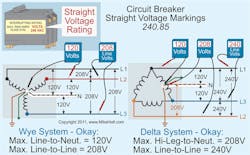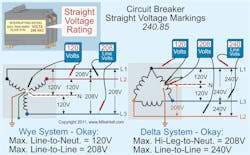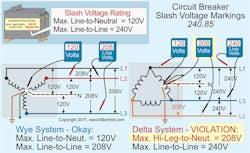All questions and answers are based on the 2011 NEC.
Q. What is the Code requirement for the use of slash versus straight voltage rated breakers?
A. A circuit breaker with a straight voltage rating, such as 240V or 480V, is permitted on a circuit where the nominal voltage between any two conductors (line-to-neutral or line-to-line) doesn’t exceed the circuit breaker’s voltage rating [240.85], as shown in Fig 1.
A circuit breaker with a slash rating, such as 120/240V or 277/480V, is permitted on a solidly grounded system where the nominal voltage of any one conductor to ground doesn’t exceed the lower of the two values, and the nominal voltage between any two conductors doesn’t exceed the higher value.
Caution: A 120/240V slash circuit breaker must not be used on the high leg of a solidly grounded 4-wire, 3-phase, 120/240V delta-connected system, because the line-to-ground voltage of the high leg is 208V, which exceeds the 120V line-to-ground voltage rating of the breaker (Fig. 2).
Note: When installing circuit breakers on corner-grounded delta systems, consideration needs to be given to the circuit breakers’ individual pole-interrupting capability.
Q. What are the NEC rules regarding the installation of service entrance cable?
A. Service entrance cable used as service entrance conductors must be installed in accordance with Art. 230 [338.10]. Type SE service entrance cable is permitted for branch circuits and feeders where the circuit conductors are insulated [338.10(B)(1)]. SE cable is permitted for branch circuits and feeders if the insulated conductors are used for circuit wiring, and the uninsulated conductor is only used for equipment grounding purposes [338.10(B)(2)].
Exception: In existing installations, uninsulated conductors may be used for the neutral conductor if the uninsulated neutral conductor of the cable originates in service equipment.
SE cable must not be subjected to conductor temperatures exceeding its insulation rating [338.10(B)(3)]. SE cable used for branch circuits or feeders must comply with (a) and (b) [338.10(B)(4)]:
(a) SE cable used for interior branch circuit or feeder wiring must be installed in accordance with the same requirements as Type NM cable — Art. 334, excluding 334.80. The maximum conductor temperature rating can be used [310.15(B)(2)] for ampacity adjustment and correction purposes. But when installed in thermal insulation, the conductors must be sized in accordance with Table 310.15(B)(16) 60°C rated conductor column.
Caution: Underground service-entrance cable (USE) is not permitted for interior wiring because it does not have a flame-retardant insulation. It would only be permitted in interior wiring when dual listed as wire type in accordance with Table 310.104, such as RHW.
(b) SE cable used for exterior installations must be supported in accordance with 334.30 and, where run underground, the cable must comply with Part II of Art. 340.
On the other hand, SE cable is not permitted under the following conditions or locations [338.12(A)]:
• If subject to physical damage unless protected in accordance with 230.50(A).
• Underground with or without a raceway.
What about underground service-entrance cable? USE cable isn’t permitted:
• For interior wiring.
• Above ground, except where protected against physical damage in accordance with 300.5(D).
Q. What are the rules for minimum clearance above ground for overhead conductors?
A. Overhead conductor spans must maintain vertical clearances as follows [225.18]:
• 10 ft above finished grade, sidewalks, platforms, or projections from which they might be accessible to pedestrians for 120V, 120/208V, 120/240V, or 240V circuits.
• 12 ft above residential property and driveways, and those commercial areas not subject to truck traffic for 120V, 120/208V, 120/240V, 240V, 277V, 277/480V, or 480V circuits.
• 18 ft over public streets, alleys, roads, parking areas subject to truck traffic, driveways on other than residential property, and other areas traversed by vehicles (such as those used for cultivation, grazing, forestry, and orchards).
• 24½ ft over track rails of railroads.
Overhead conductors located above pools, outdoor spas, outdoor hot tubs, diving structures, observation stands, towers, or platforms must be installed in accordance with the clearance requirements in 680.8.
About the Author

Mike Holt
Mike Holt is the owner of Mike Holt Enterprises (www.MikeHolt.com), one of the largest electrical publishers in the United States. He earned a master's degree in the Business Administration Program (MBA) from the University of Miami. He earned his reputation as a National Electrical Code (NEC) expert by working his way up through the electrical trade. Formally a construction editor for two different trade publications, Mike started his career as an apprentice electrician and eventually became a master electrician, an electrical inspector, a contractor, and an educator. Mike has taught more than 1,000 classes on 30 different electrical-related subjects — ranging from alarm installations to exam preparation and voltage drop calculations. He continues to produce seminars, videos, books, and online training for the trade as well as contribute monthly Code content to EC&M magazine.


